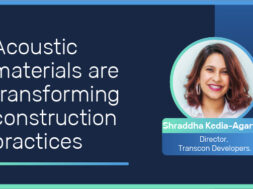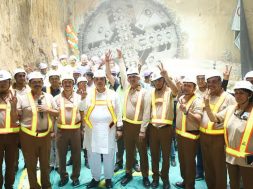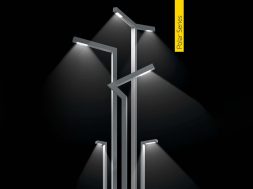Acoustic materials are transforming construction practices

Emphasising the significance of sustainability in the construction sector, Shraddha Kedia- Agarwal, Director of Transcon Developers, highlights sustainability contemporary materials and technologies are essential in the construction process. They are vital to creating high-quality, reliable structures.
What should be done to ensure that the entire construction phase of a project and the design adhere to sustainability?
Sustainability is an essential factor to consider in any construction project. To ensure that the entire construction phase is sustainable, it is crucial to have a strict regime of checklists for quality control (QC), quality assurance (QA), and health and safety compliance (HSE). In addition, the design of the project should also be sustainable.
This means that the materials used should be environmentally friendly, the design should optimise the use of natural resources, and the project should have no negative impact on the environment. Moreover, the design should also consider the project’s long-term effects and ensure that all materials have the parameters of durability and timetestiness to ensure that the construction adheres to sustainability principles.

Additionally, electrical bus risers in highrise buildings should be equipped with a monitoring system that can detect and alert to any anomalies in the system, such as voltage and current variations, changes in temperature and humidity, or any other irregularities. This will help to ensure that the construction is safe and efficient in terms of energy consumption. Furthermore, sound barriers should be installed in areas where noise levels are high to reduce noise pollution. This can be done by installing sound absorbing materials such as acoustic panels, curtains, and wallboards.
These materials will help reduce the amount of noise and air pollution in the surrounding area. The use of renewable energy sources such as solar and wind power should be encouraged, as these sources can reduce the number of carbon emissions that are produced during the construction process. By considering all of these factors, it is possible to ensure that the construction project is sustainable and positively impacts the environment.
Which critical contemporary materials and technologies are essential in construction?
Constructions today are increasingly complex, with various materials and technologies being used as part of the process. Ready-mix concrete and mortar are two of the most commonly used materials in construction and are essential for building strong and reliable structures. Post-tensioning is another important contemporary technology used to reinforce structures and increase their durability.
The latest survey machines, such as total stations, are essential in construction, as they allow for accurate measurements and the calculation of the exact layout of a structure. The use of membrane waterproofing for underground structures is also becoming increasingly important, ensuring that the structure is protected from water damage. Finally, material-lifting machinery such as towers and luffing cranes is also essential in construction, as these powerful mechanisms can easily lift and move heavy materials.
The latest models of this machinery, increasingly sophisticated, can lift and move materials with greater precision and accuracy. All these contemporary materials and technologies are essential in the construction process and are vital to creating high-quality, reliable structures. With suitable materials and technologies, construction companies can ensure that they can build solid and durable structures that will stand the test of time.

Which innovations are helping the contractors meet project deadlines?
The construction industry is rapidly evolving and embracing the latest innovations to help contractors meet project deadlines. Modern formwork and safety systems such as MFE and PERI are assisting contractors to save time and money by reducing the amount of labour and materials needed. Precast-type construction has also revolutionised the industry, allowing contractors to produce prefabricated components in factories and save on-site time.
Readily cut-and bent steel is another innovation that has enabled contractors to reduce labour costs and complete projects faster. The steel can be cut to size and bent to the required shape without welding, saving time and money. Electrically-operated machinery is also helping contractors to speed up the construction process and ensure projects are completed on time while also reducing the overall sound and preventing noise pollution.
The machinery allows for faster and more precise construction, which reduces the need for rework and ensures projects are completed to the highest standards. Overall, innovation and modern technology are helping contractors meet project deadlines and stay competitive in the industry. The use of contemporary formwork and safety systems, pre-cast type construction, readily cut-and-bend steel, and electrically operated machinery are all helping contractors complete projects faster and more efficiently.

How do facades contribute to highrise buildings’ aesthetics and energy efficiency?
Facades play an essential role in high-rise buildings’ aesthetics and energy efficiency. By reducing the air conditioning heat load and improving comfort, facades can help improve thermal efficiency. The use of natural light and the scope for natural ventilation further help to reduce energy costs. Facades also have an essential role in high-rise buildings’ aesthetics. With a wide range of materials, textures, and colours available, facades can be used to create unique and eye-catching designs.
This means the building doesn’t lose its beauty compared to a standard external wall. In addition, facades can help reduce the urban heat island effect by reflecting more light away from the building and reducing the amount of energy absorbed.
This helps reduce the energy required for air conditioning and improve the air quality around the building. Overall, it is clear that facades play an important role in high-rise buildings’ aesthetics and energy efficiency. By reducing the air conditioning heat load, improving thermal efficiency, and providing scope for natural ventilation, facades can help reduce energy costs while creating unique and eye-catching designs.
What challenges are faced by the developers’ contractors in meeting the cost-effective demands of customers?
Other than rising material costs, labour shortages, and competition from other contractors when trying to meet the cost-effective demands of customers, the contractors face several other challenges as well. Site logistics due to a limited area of operation and delays due to quality output issues can lead to increased costs and delays in project completion. These contractors also face challenges while ensuring compliance with health, safety, and environmental regulations, providing adequate training for workers, and ensuring proper equipment maintenance when managing health, safety, and environmental requirements.
Cookie Consent
We use cookies to personalize your experience. By continuing to visit this website you agree to our Terms & Conditions, Privacy Policy and Cookie Policy.









